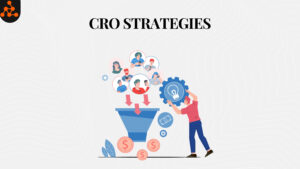Driving traffic to your website is only half the battle, the real challenge is converting that traffic into leads, customers, or subscribers. This is where Conversion Rate Optimization (CRO) comes into play. CRO is a strategy that helps businesses increase the percentage of website visitors who take a desired action, like making a purchase, signing up for a newsletter, or filling out a contact form. Dive into our comprehensive guide to conversion rate optimization and start maximizing your conversion rates today.
In this blog, we’ll dive into what CRO is, why it matters, and how you can use it to improve your website’s performance.
What is Conversion Rate Optimization (CRO)?
Conversion Rate Optimization (CRO) is the process of making changes to your website to encourage more visitors to take specific actions. These actions, known as “conversions,” can vary depending on your business goals. For example:
- For an online store: A conversion might be a product purchase.
- For a software company: It could be someone signing up for a free trial.
- For a blog: A conversion could be a visitor subscribing to your newsletter.
Simply put, CRO helps you get more value from your existing website traffic by making it easier for people to do what you want them to do.
Why is CRO Important?
Conversion Rate Optimization (CRO) is a critical strategy for maximizing the value of your existing website traffic. Rather than continuously investing in costly ads or marketing campaigns to attract more visitors, CRO focuses on converting a higher percentage of your current visitors into customers or leads. This not only improves the effectiveness of your website but also boosts your bottom line. Here’s why CRO is essential:
1. Increases Revenue: Even a small improvement in your conversion rate can significantly impact your sales and lead generation. For example, if you can increase your conversion rate from 1% to 2%, you’ll effectively double your sales without needing to drive additional traffic.
2. Enhances User Experience: CRO is all about understanding what your visitors need and optimizing your site accordingly. By removing barriers to conversion and improving navigation, you create a more intuitive and enjoyable experience for your users.
3. Maximizes ROI: Instead of focusing solely on increasing traffic, CRO helps you get more value out of every visitor. This approach leads to a higher return on investment (ROI) for your marketing efforts, making your campaigns more cost-effective.
For example, if you have 1,000 visitors and 10 convert, you have a 1% conversion rate. Improving that to 2% doubles your sales without additional costs, showcasing the true value of CRO.

How to Calculate Conversion Rate?
Calculating your conversion rate is simple yet essential for gauging your website’s effectiveness. Use this formula:
Conversion Rate = (Number of Conversions / Total Number of Visitors) × 100
For example, if your website had 5,000 visitors last month and 150 made a purchase, your conversion rate would be:
(150 / 5,000) × 100 = 3%
This metric shows the percentage of visitors who completed the desired action, helping you assess how well your site is converting traffic into leads or customers.

Key Components of an Effective CRO Strategy
Now that you know what CRO is, let’s look at the key elements that make up a successful CRO strategy:
1. Understanding User Behavior
To improve your website’s conversion rate, you need to understand how visitors are interacting with your site. Tools like Google Analytics can help you see which pages people are visiting, how long they stay, and where they drop off. You can also use heatmaps and session recordings from tools like Hotjar to see where users are clicking and scrolling.
2. A/B Testing
A/B testing, or split testing, is when you compare two versions of a webpage to see which one performs better. For example, you could test two different headlines on your homepage to see which one gets more people to click on a call-to-action button. This data helps you make decisions based on what your audience actually responds to.
3. Improving Website Usability
A website that is easy to use and navigate is more likely to convert visitors into customers. Make sure your website loads quickly, is mobile-friendly, and has a clear and logical structure. The easier it is for visitors to find what they’re looking for, the more likely they are to convert.
4. Creating Compelling Content
The words on your website matter a lot. Your headlines, descriptions, and call-to-action buttons should clearly communicate what your business offers and why someone should take action. Avoid using jargon or complicated language. Instead, focus on being clear, concise, and persuasive.

Measuring and Analyzing the Success of Your CRO Efforts
After implementing changes to optimize your website’s performance, it’s crucial to rigorously evaluate their impact. This involves tracking key metrics to gain actionable insights into what’s working and where further optimization is needed.
1. Conversion Rate: This is your primary indicator of success. How many of your website visitors are taking the desired actions, such as making a purchase, signing up for a newsletter, or filling out a form? An increasing conversion rate means your CRO efforts are on the right track.
2. Bounce Rate: This metric shows the percentage of visitors who leave your site after viewing only one page. A high bounce rate could indicate that your site isn’t engaging enough or that it’s not delivering on user expectations. Lowering this rate suggests you’re successfully capturing visitor interest.
3. Average Time on Site: This tells you how long users are staying on your website. A longer duration suggests that visitors are finding your content valuable and engaging. If this metric increases, it’s a good sign that your changes are improving user experience.
By closely monitoring these metrics, you can identify what’s resonating with your audience and where you may need to adjust your strategy. Remember, Conversion Rate Optimization is not a one-time task but a continuous process of testing, learning, and refining. Consistently analyze your results and iterate on your strategies to keep enhancing your conversion rates and driving better business outcomes.
Real-World Examples of Successful CRO
1. Airbnb: Simplifying Host Sign-Up Process
Challenge: Increase the number of hosts signing up on the platform.
CRO Approach: Airbnb applied A/B testing to refine its host registration process. They removed unnecessary fields, clarified instructions, and provided visual cues to simplify onboarding.
Result: These optimizations led to a 30% increase in host sign-ups, making the process more intuitive and efficient.
2. Conversion Crimes: User Testing for Small Businesses
Challenge: Provide an affordable and efficient CRO tool for small businesses that struggle with expensive usability testing options.
CRO Approach: Conversion Crimes built an accessible user testing platform that addressed pain points like complexity and cost. They focused on improving usability for smaller companies through simplified testing and feedback processes.
Result: The platform saw immediate success, generating $10,000 revenue in its first month, with annual revenues growing to $120,000
3. 99designs: Optimizing Landing Pages
Challenge: Increase client engagement and project creation on the platform.
CRO Approach: 99designs used A/B testing on landing pages, modifying layout, messaging, and call-to-action buttons. They also improved the checkout process to reduce cart abandonment.
Result: This led to a 10% increase in conversion rates, enhancing both user experience and platform engagement.
Conclusion
Conversion Rate Optimization (CRO) is a powerful strategy to grow your business by maximizing the value of your existing website traffic. By understanding your audience, experimenting with different approaches, and continuously refining your website, you can convert more visitors into loyal customers and achieve your business objectives more efficiently.
If you haven’t begun your CRO journey yet, now is the time to evaluate your website’s performance and pinpoint areas for improvement. Remember, even small changes can lead to significant results.
Looking for expert guidance to navigate the complexities of CRO? At SalesHarbor, we specialize in crafting and implementing tailored strategies that align seamlessly with your business goals. Schedule a quick intro call with us to discover how we can help optimize your conversions and drive sustainable growth for your business.



